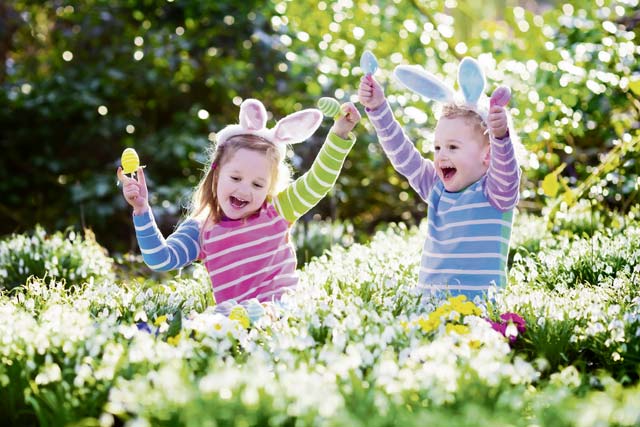
The meaning of Easter is universal, but it’s celebrated differently throughout the world. Even in the various states of Germany, people observe different traditions and customs. Little trees in backyards are decorated with Easter eggs, special Easter wreaths hang on entrance doors, and in houses, Germans put branches of forsythias, willow catkins and other trees in vases and decorate them with Easter eggs and ornaments. In some towns, Easter trees are put up, fountains are decorated with eggs, flowers and garlands, and Easter markets with selling booths and merry-go-rounds are held.
The Easter market in Kaiserslautern with merry-go-round is set up in front of Stiftskirche and continues through Thursday.
The Kaiserslauten Garten-schau will have a life-sized Easter Bunny passing out Easter treats to children starting at 1 p.m. April 1.
For children, the most famous symbol of Easter is the Easter Bunny, who is as fascinating as Santa Claus. But while they get to see Santa Claus, the Easter Bunny stays invisible. Children believe that the Easter Bunny and his helpers dye the eggs, bring them to their homes and hide them in the house or in the backyard for them to find. The hunt for Easter eggs is the main feature of Easter for children.
The symbol of the Easter egg began in the ancient past. Early philosophers gave special significance to the oval shape of elemental things, from the raindrop to the seed, and the oval Easter egg is an outgrowth of ancient pagan rites associated with the rebirth of nature.
For the Egyptians, Greeks and Romans, the egg was a symbol of fertility and life. They put clay and marble eggs in graves to facilitate the dead passing into another world.
In China 5,000 years ago, it was tradition to give away decorated eggs for the beginning of spring. In Finland, people claim that the universe derived from one giant egg. In Persia, eggs were only combined with spring festivities, because during the season of the new sun, poultry started laying eggs again.
It has not been explored why eggs play such a big role on Easter. A reason might be the strict prohibition by church to eat eggs during Lent.
In former times, decorated eggs were given as gifts throughout the year. Later it was just done on Easter. It was not only the Easter Bunny giving away eggs, but also storks, foxes and donkeys were the bearers of eggs in mythology. In 1682, the Easter Bunny was mentioned for the first time. When the production of Easter chocolate and bunnies as well as the printing of Easter picture books and postcards began around 1850, the long-eared bunny became an Easter trademark.
In Germany, Easter celebrations start the Thursday before Good Friday, called “Gruendonnerstag,” or green Thursday. The word green is not associated with the color but rather with the old German verb “grienen,” which means “to bemoan.” It’s a custom in German families to eat green vegetables that day, preferably spinach.
The following day, Good Friday, is an official German holiday. For Protestants it is one of the most important religious holidays, while Roman Catholics strictly observe it as a day of fasting.
Editor’s Note:
This article was published in a previous edition of the Kaiserslautern American and the information has been updated to reflect this year’s events.


